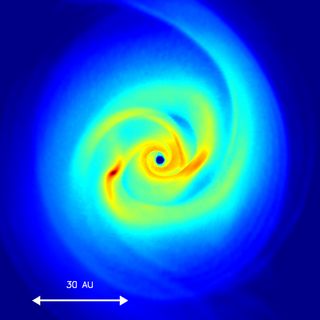Some of Universe's First Stars May Still Be Visible

A new study that suggests the first stars in the universe formed in groups instead of in isolation, as previously thought, also has found something else: Some of these first stars may still be visible today.
The study, which used supercomputers to simulate the formation of the first stars in the universe, recreated a system of protostars – the precursors to full-blown stars – created from the same cloud of gas at nearly the same time.
The simulation revealed that a central protostar would be created first and would become the most massive, much as was predicted in the previous view of the universe. A number of smaller protostars would follow.
But sometimes the gravitational pull from the other seeded stars would catapult one of the members out of the system.
The ejected star would have to be very young, only around 100,000 years old, the researchers said. Because the age of a star and its mass are linked — the more massive a star, the faster it tends to age — a low-enough mass in the newly single star could mean it still had a long-enough life ahead of it to make it visible today, they said.
But it would have had to be ejected while its mass was in a very narrow range.
The universe is estimated to be 13.7 billion years old. "To survive for the 13 billion years since the end of the dark ages, when they were formed, the star could not have been more massive than a solar mass or so," said study co-investigator Volker Bromm, an astronomer with the University of Texas at Austin. "Even a little bit [more] mass pushes it over the boundary of survival."
Sign up for the Live Science daily newsletter now
Get the world’s most fascinating discoveries delivered straight to your inbox.
Then, too, there is the challenge of locating such a star among the billions that came after.
The ideal place to search would be the center of the Milky Way. However, only a few hundred to a few thousand may exist, and they would be intermixed with the billions of stars that have since formed.
"This is the ultimate needle-in-a-haystack search," Bromm said.
The situation isn't completely hopeless. Modern large-scale digitized surveys vastly increase the odds of locating such a star.
NASA's planned James Webb Space Telescope is expected to search for early galaxies and stars using its ultra-deep near-infrared surveys. Several large ground-based telescopes, like the planned Extremely Large Telescope (ELT), also are expected to be able to peer further back than ever into the early days of the universe. Such instruments could potentially detect such a star.
Locating a primordial star, known as a Population III star, would provide astronomers with data about the early universe. The abundance of deuterium and lithium — which the Big Bang would have created — could be directly measured rather than inferred.
Similarly, these stars would provide solid data for theoretical models.
"For once, we would know that the star formation process in the early universe did enable low-mass stars to form," Bromm said. "On the other hand, if an extensive search of the Milky Way's bulge turns up empty, we would know that our models need to explain why virtually all Population III stars grew to be more massive."
This story was provided by SPACE.com, a sister site to LiveScience.

